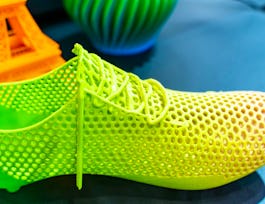Optical and X-ray techniques are powerful ways to characterize semiconductor thin films. They can be used to measure film thickness, purity and crystalline quality, and for compositional analysis. Modern techniques are fast, turn-key, and generally non-destructive, allowing for rapid assessment of material properties. This course describes the fundamentals of optical and X-ray characterization and provides real-world examples of how they are used in semiconductor manufacturing.



Optical and X-Ray Characterization
This course is part of Semiconductor Characterization Specialization

Instructor: Trevor Thornton
Sponsored by Pontificia Universidad Católica del Perú
(14 reviews)
Recommended experience
What you'll learn
Describe the use of light to measure the thickness and refractive index of thin transparent films.
Explain how light is absorbed and emitted by semiconductors.
Explain the advantages and limitations of optical and X-ray characterization.
Details to know

Add to your LinkedIn profile
5 assignments
See how employees at top companies are mastering in-demand skills

Build your subject-matter expertise
- Learn new concepts from industry experts
- Gain a foundational understanding of a subject or tool
- Develop job-relevant skills with hands-on projects
- Earn a shareable career certificate


Earn a career certificate
Add this credential to your LinkedIn profile, resume, or CV
Share it on social media and in your performance review

There are 6 modules in this course
Optical and X-ray techniques are powerful ways to characterize semiconductor thin films. They can be used to measure film thickness, purity and crystalline quality, and for compositional analysis. Modern techniques are fast, turn-key, and generally non-destructive, allowing for rapid assessment of material properties. This course describes the fundamentals of optical and X-ray characterization and provides real-world examples of how they are used in semiconductor manufacturing.
What's included
1 video2 readings
This week introduces the concept of reflectance spectroscopy: a rapid, convenient, and non-destructive technique for measuring the thickness of transparent materials.
What's included
2 videos1 reading1 assignment
This week, you will learn about ellipsometry, a powerful technique that allows us to extract the thickness and refractive index of transparent layers as thin as a few nanometers.
What's included
1 video1 reading1 assignment
This week, you will learn about photoluminescence.
What's included
1 video1 reading1 assignment
This week, you will learn about electron microprobe X-ray analysis.
What's included
2 videos1 assignment
This week, you will complete a case study to assess your ability to analyze electron microprobe x-ray images to determine the constituent elements in a 40 nm MOSFET.
What's included
1 video1 reading1 assignment
Instructor

Offered by
Why people choose Coursera for their career




Learner reviews
14 reviews
- 5 stars
92.85%
- 4 stars
0%
- 3 stars
0%
- 2 stars
7.14%
- 1 star
0%
Showing 3 of 14
Reviewed on May 8, 2024
Quick introduction and review of important topics. I wish if more such courses are introduced.
Recommended if you're interested in Physical Science and Engineering

University of Michigan

Coursera Project Network

Arizona State University

The Hong Kong University of Science and Technology

Open new doors with Coursera Plus
Unlimited access to 10,000+ world-class courses, hands-on projects, and job-ready certificate programs - all included in your subscription
Advance your career with an online degree
Earn a degree from world-class universities - 100% online
Join over 3,400 global companies that choose Coursera for Business
Upskill your employees to excel in the digital economy


